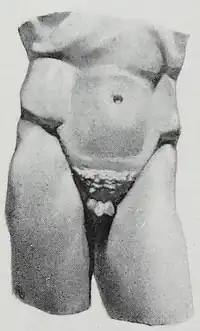Apollo's belt


The Apollo's belt, also known as Adonis belt or iliac furrow, is a term for a part of the human anatomy. It refers to two shallow grooves of the surface anatomy of the human abdomen running from the iliac crest (hip bone) to the pubis.
The term "iliac furrow" does not appear in any of the abstracts indexed by PubMed.[1] It is not a currently defined term in Terminologia Anatomica, though it has been used as a formal anatomical term in the past.[2] In modern usage, it is more common to discuss the surface anatomy in terms of nearby structures such as the inguinal ligament or iliac crest.
The term "iliac furrow" is still encountered in art history.[3][4] Because the visibility of the "belt" is a sign of low body fat, the terms "Apollo's belt" and "Adonis belt" are often used by bodybuilders and their admirers.
References
- ↑ "iliac furrow: search results". PubMed. Retrieved 2020-06-22.
- ↑ p. 1313
- ↑ L. D. Caskey; J. D. Beazley. "78. 01.8020 CUP from Orvieto PLATE XL". Attic Vase Paintings in the Museum of Fine Arts, Boston. Perseus Project. Retrieved 2020-06-22.
- ↑ Barbara Hughes Fowler; Warren G. Moon, eds. (1995). Polykleitos, the Doryphoros, and Tradition. University of Wisconsin Press. ISBN 9780299143107.
| Look up iliac furrow in Wiktionary, the free dictionary. |